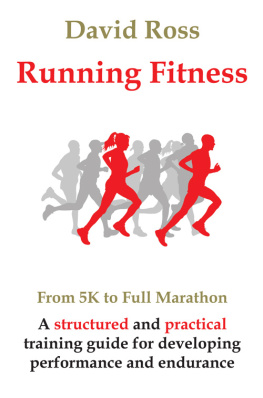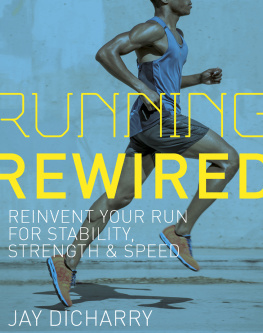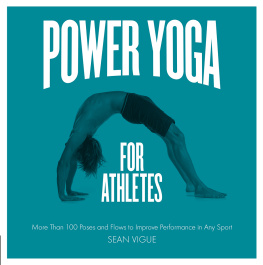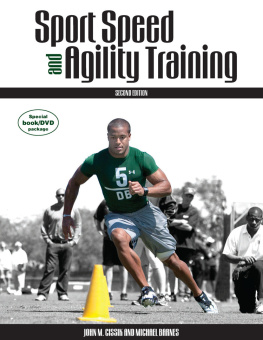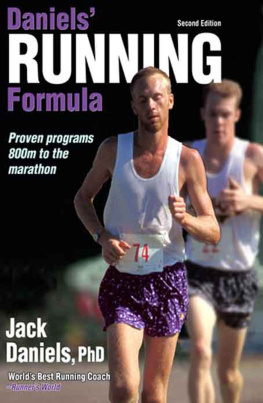

Copyright 2018 by Pete Magill
All rights reserved. Published in the United States of America by VeloPress, a division of Pocket Outdoor Media, LLC

3002 Sterling Circle, Suite 100
Boulder, CO 803012338 USA
VeloPress is the leading publisher of books on endurance sports. Focused on cycling, triathlon, running, swimming, and nutrition/diet, VeloPress books help athletes achieve their goals of going faster and farther. Preview books and contact us at velopress.com.
Distributed in the United States and Canada by Ingram Publisher Services
The Library of Congress has cataloged the printed edition as follows:
Name: Magill, Pete, author.
Title: Speedrunner: 4 weeks to your fastest leg speed in any sport / Pete Magill.
Other titles: Speed runner
Description: Boulder, CO: VeloPress, 2018. | Includes bibliographical references and index. |
Identifiers: LCCN 2017061627 (print) | LCCN 2018000735 (ebook) | ISBN 9781937716998 (ebook) | ISBN 9781937715786 (pbk.: alk. paper)
Subjects: LCSH: Running speedHandbooks, manuals, etc. | RunningTrainingHandbooks, manuals, etc. | RunningPhysiological aspectsHandbooks, manuals, etc. | Runners (Sports)Handbooks, manuals, etc.
Classification: LCC GV1061.5 (ebook) | LCC GV1061.5 .M238 2018 (print) |
DDC 613.7/172dc23
LC record available at https://lccn.loc.gov/2017061627
Photos by Diana Hernandez
Art direction by Vicki Hopewell
Cover design by Kevin Roberson
v. 3.1
A note to readers: Double-tap on figures and tables to enlarge them. After art is selected, you may expand or pinch your fingers to zoom in and out.
CONTENTS
I n sports, the difference between a star and an also-ran is tenths of a second.
Athletes who are faster, stronger, and quicker dominate. Athletes who lack these characteristics languish. This is true no matter the sport. In football, 40-yard-dash times can determine who gets playing time and who rides the bench. In soccer, the ability to execute a change-of-direction dribble can make the difference between a shot on goal or the defender clearing the ball. In basketball, there is no fast break on a team with slow feet. In tennis (which averages 3 to 5 changes of direction for 8 to 12 yards of movement per point), a sluggish first step can lead to a winfor your opponent. In baseball, your speed to first base can earn you a hit, while a middle fielders speed and lateral quickness can rob you of the same. In volleyball, theres no spike or block without the vertical explosiveness to rise above the net. And in track & field, athletes who can generate the most horizontal and vertical force go home with the medals. In sport after sport, its the speed, strength, and agility you produce with your legs that determines what you can accomplish on the field, court, or track.


 SPEEDRUNNER
SPEEDRUNNER
A student of advanced human locomotion; someone who trains his or her nervous system and muscles to produce maximum speed, power, and agility

Theres an old-school saying in track & field: God makes sprinters, coaches make milers. This outdated belief stems from the erroneous assumption that youre stuck with the speed that God, evolution, and your parents gave you. Maybe you can build a bigger heart and better endurance to become a miler, but improve your speed? No way! Except that modern sprint coaches figured out a way, and in 2016, a total of 23 runners recorded 53 performances at 100 meters that were faster than Carl Lewis (Sports Illustrateds Olympian of the Century) ran for his 100-meter gold medal at the 1984 Los Angeles Olympics.
Across all sports, athletes are getting better, and their skill set of speed, strength, and agility is improving. When you consider that, in America, approximately 45 million youth athletes (ages 6 to 17) and 25 percent of the adult population are active in sports, coaches can be forgiven for skipping over athletes who arent prepared. Frankly, if your skill set is lacking, you need to improve it. These days, showing up for a team-sports tryout or competition without a developed skill set is like taking on Joey Chestnut at Nathans Famous International Hot Dog Eating Contest without an appetite.
Al Davis, the late, outspoken owner of professional footballs Oakland (soon to be Las Vegas) Raiders, famously said, You cant teach speed. Lucky for you, Al Davis was wrong. Speed can be taught. And it can be learned. In fact, not only can speed be learnedalong with strength, agility, balance, and proprioceptionbut its essential that any athlete looking to achieve his or her maximum potential do just that.

WHATS THE SPEEDRUNNER SYSTEM?
THE SPEEDRUNNER SYSTEM is a 4-week, 12-session program designed to improve your athletic performance. There are also modified schedules for athletes focused solely on speed (e.g., team-sports athletes already enrolled in agility and strength-training programs), endurance athletes looking for a once-a-week combination speed- and injury-prevention workout, and fitness enthusiasts whod like additional, stand-alone sessions beyond the initial program.
SpeedRunner creates positive training adaptations by teaching your nervous system to better control your muscles and connective tissue (e.g., your bones and tendons). It targets three physical skills that are a requirement for every sport.

Of course, it all begins with speed. Speed is a dividing line in sports, like height requirements for amusement park rides. Once you have speedthe ability to move from point A to point B faster than others on the field, court, or trackyoure already, literally, a step ahead of the competition. Add strength and agility, and you have a skill set thats prized in every sport.
The SpeedRunner system grew out of my own five-decade involvement in sports. I was a multisport athlete growing up, but my turning point in workout philosophy dates back 35 years to my time in Eugene, Oregon (Americas track mecca), where I was training as a middle-distance runner. A friend of mine who ran with Nikes elite Athletics West program would meet me once a week under the bleachers at Hayward Fieldrain beating down on the track, our breath like fog in the frigid temps, both of us bundled in sweatsand teach me the technique drills hed learned with the club. Wed skip, bound, march, and do the Ovett Drill (a variation of Quick Feet named after one of the worlds best milers), alternating reps of each drill with a sprint, for roughly two hours. The workout was designed to create nervous system adaptations that result in a more efficient stride. And, voil, the next day my stride would be smoother and my pace faster.
Next page

